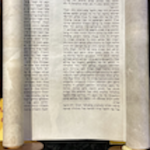God and Evolution: A Reader, edited by Mary Kathleen Cunningham (New York: Routledge, 2007)
If there is a hurdle that often confronts those seeking to understand and think through the relationship between God and evolution, it is an awareness and appreciation of the range of views on the subject. Cunningham’s reader goes a good way towards providing an up-to-date collection of key excerpts from the most important representatives of various positions and viewpoints in this area. More often than not, people are more aware of the positions that present the choice as “either/or” than with those that see the situation as “both/and”. This aspect of popular understanding particularly affects educators like myself, since it represents the starting point of the majority of students in any given class addressing the topic of religion and science. Generally, professors have to put together a packet of readings much like this one, and thus a reader such as this one provides a useful resource for use in classes.
Cunningham’s reader is divided into seven sections: methodology, evolutionary theory, creationism, intelligent design, naturalism, evolutionary theism, and reformulations of tradition. A particular strength of the collection is that it seeks to do more than provide a selection of contemporary viewpoints. A historical perspective is offered, including important excerpts from the past as well as more recently. The authors whose works are excerpted include philosophers of science and theologians as well as evolutionary biologists. Having a single volume whose contributors include Charles Darwin and William Paley, Michael Behe and Richard Dawkins, is itself impressive. Each section begins with an introduction that helps guide the reader to important similarities and differences between the selections, filling in useful background knowledge that makes the readings themselves more accessible.
The first part, methodology, is focused primarily on method in theology, with a consideration of how language and method in theology relate to language and method in science. This section would have benefited from the inclusion of a discussion of what science is, and how it works, written by a philosopher of science or a biologist who was not specifically concerned with the relationship to or comparison with religion. Nevertheless, what is included is extremely helpful. Some of the excerpts are primarily focused on religion and science in general, rather than specifically on God and evolution, but this broader framework is helpful, in particular for those coming from a background of greater familiarity with either religion or science, but not both.
In the introduction to this section, some creationists are characterized as “espousing a literal interpretation of Genesis”. Such language is extremely common, but it grants to the groups in question a “high ground” that they do not in fact occupy. Perhaps it is more evident to scholars in my own field of Biblical studies that the claim of some creationists to “believe the whole Bible” and “take it all literally” are in fact false. I have yet to meet someone who understands the dome in Genesis 1 literally, or who believes that human beings are literally made from soil. The list could continue. All literalism is selective literalism, and by this I am not referring to the entirely appropriate distinction between parts of the Bible that are poetic and others that are not. Even within the creation stories that are supposedly being “interpreted literally”, details that are incompatible with other aspects of modern science and technology are conveniently ignored or spiritualized, since Christians who use cell phone are well aware that the rockets that launched the satellites they depend on did not bump up against a literal firmament in which sun, moon and stars were set. This is important, because as long as conservative Christians remain under the illusion that they are being faithful to the Bible and interpreting it consistently, it is hard to make any further progress in discussing topics related to evolution.
The first excerpt is from the 19th century Protestant theologian Charles Hodge. Although Hodge’s name is quite likely unfamiliar to most people today, it still carries weight with those studying theology in fundamentalist seminaries. This excerpt is thus significant, since it illustrates well the fact that, when Christian fundamentalism first developed, it did not regard a young earth as one of the fundamentals that gave the movement its name. This selection also illustrates some of the principles of Biblical interpretation that distinguish popular piety from the approach taken by theologically-educated Christians and scholars of the Bible (e.g. the assumption that the Bible cannot contradict itself, as opposed to the scholarly approach that lets the evidence in the Bible itself to determine the conclusion that at times it clearly does).
The other excerpts in this section are by Sallie McFague, Mary Midgley and Ian Barbour, and reflect a more mainstream approach to religious language and theology. While religious fundamentalists pride themselves on their alleged literalism, most theologians are aware of the danger of idolatry inherent in such an approach, and even for those who are seeking to avoid this pitfall. Most religious traditions define God as beyond human understanding, which means that all human statements are at best symbols and analogies which point to a transcendent, ineffable reality. While such disclaimers may seem out of sync with popular piety, it is no more necessary or appropriate to treat religion in terms of popular understanding, than to define science by what most people understand or think they know. It must be asked whether a lack of education about their own religious tradition often plays as much a role in the attitudes people have towards evolution, as does a lack of accurate scientific information.
Part two presents evolutionary theory, with excerpts from Darwin’s Origin of Species as well as works by Francisco Ayala and Michael Ruse. The latter are appropriate choices, since these individuals illustrate that a Christian can be a prominent evolutionary biologist, and that an atheist philosopher of science can see no inherent incompatibility of evolution and Christianity. Ayala spends some time talking about the evolutionary views of Church Fathers as well as more recent papal pronouncements on the subject. Both Ayala and Ruse distinguish between the fact of evolution (which is as far beyond doubt as any scientific fact could hope to be), the path of evolutionary development down the ages (some parts of which are more certain than others), and the mechanisms that drive evolution (which are much more controversial, although no one regards natural selection as either totally irrelevant or a complete explanation on its own). The distinctions are important ones that are often overlooked when people discuss “evolution”. Although perhaps an excerpt from some cutting-edge scientific work in areas like evolutionary developmental biology might have nicely illustrated the current state of work on the genetics behind biological changes, for professors using this as a textbook, adding a supplemental excerpt is not difficult.
The third part, entitled simply “Creationism”, is rather more problematic. The terms creationist and creationism, used on their own, are often misleading, since in and of themselves the terms simply affirm the belief that what exists depends on something greater than itself, without necessarily implying that the creator worked through causes other than natural processes to bring about the current state of the universe. Be that as it may, this section consists of only two readings. The first is simply the first two chapters of Genesis. On the one hand, it was a good choice to use the translation of the New Revised Standard Version, which neither presupposes that the creation described was a creation out of nothing (the Hebrew in Genesis 1:1 is ambiguous on this point), nor tries to cover up elements of a pre-scientific worldview such as the dome. On the other hand, just as the section that follows on intelligent design will highlight the problems with ID’s conclusions, here too it would have been useful to provide an example of scholarly treatment of these chapters. I regularly use an excerpt by Gordon J. Wenham, a British Evangelical who is a leading expert on Genesis and helpfully shows how the point of these stories, rather than relating directly to modern science, has to do instead with the understanding of the world held by many in the time the stories were written. Without this scholarly analysis, showing that the order of the days has more to do with parallelism than chronology, and that there seem to in fact be two creation stories in these chapters, it is that much harder to get young-earth creationists (the real focus of this part of the book) over the hurdles that keep them from accepting the overwhelming scientific evidence for evolution. It might also have been useful to include here something written by a young-earth creationist author. In teaching my religion and science class this semester, I found that nothing was more effective in persuading students of the bankruptcy of the young-earth creationist approach than allowing them to read what they have to say, as well as the insightful scientific and theological analysis of their arguments by Ken Miller. But while additions such as those suggested might have improved the book, the historical overview of young-earth creationism by Ronald Numbers is very helpful. It shows that antievolutionism as it exists in the U.S. today is a relatively modern phenomenon, and certainly did not have anything like its present influence until the 20th century. Numbers’ chapter also helpfully highlights a problem that confronts all those interested in this topic, namely figuring out what the majority of Americans actually think. Many surveys ask questions that do not allow for sufficiently-nuanced answers. One wonders how many theistic evolutionists have answered a survey in a way that gave the impression they were young-earth creationists, because the other option gave the impression they were atheistic metaphysical naturalists. Asking the right questions, and leaving room for nuanced answers, is particularly important for those of us trying to stake out middle ground at any point between the extreme ends of the continuum. Numbers also provides illustration of the in-fighting between various types of creationists, as well as highlighting the importance the blaming of evolution for moral decay has as a motivating factor in the controversy. Attempts to settle the issue on the basis of scientific evidence alone are likely to have limited effect as long as the motivation for antievolutionism is not that scientific evidence, but something else altogether. Nevertheless, this chapter also gives cause for hope that the scientific evidence can indeed change minds (as the author himself can attest). The leaders of the young-earth creationist movement devoted much effort to establishing their own schools of “science”, because those who were sent to get degrees from ordinary universities regularly defected to other positions, compelled by the overwhelming scientific evidence.
Part four deals with intelligent design, and helpfully includes the most famous excerpt from William Paley’s writings, his argument for design. It is interesting to note the presupposition of the argument, which arises in the writings of Michael Behe (an excerpt of which is also found in this section). Finding a watch is compared to finding a stone, the latter of which could easily be imagined to have “lain there forever”. The historic viewpoint of Jews and Christians is, of course, that God made rocks and mountains, and not merely living things. The focus on living things, in all their complexity, is understandable, because (as Richard Dawkins writes in a later chapter) their complexity cries out for explanation. Nevertheless, the fact that the historic understanding of creation does not make this distinction is worth noting, as it shows that proponents of the design argument are out of step not merely with science but with their own religious traditions as well.
The chapter by Behe is one of his best, in the sense that it makes the case for intelligent design as well as it possibly can be made. This makes the response by Miller in the chapter that follows, which shows how much of the evidence Behe says would be needed to overturn his argument has actually been found, all the more effective. As Miller points out, if one simply took the (on the surface potentially plausible) arguments of Behe at face value, one might never check the scientific data, which does in fact contradict Behe’s claims. This, as Miller helpfully warns, “is the real scientific danger of his ideas” (p.163).
Part five presents proponents of a more sweeping naturalism than merely methodological naturalism, as well as some responses to them. The excerpts from Dawkins and Dennett are excellent samples not only of their viewpoint but of their delightful writing style. Dawkins (perhaps to the surprise of many readers) is extremely appreciative of William Paley’s design argument. It was the best one could do based on the evidence and understanding available in Paley’s time. The problem with Paley’s argument is not that it viewed biological complexity as crying out for explanation: it is simply that it got the explanation wrong. Without Darwin’s explanation of how complex organisms could evolve, there was no real viable alternative. Dawkins also offers an argument that completely knocks down intelligent design altogether. To argue from complex organisms that they must have an intelligent (and thus presumably complex) designer can only lead to an endless chain of designers or to a complex being whose existence is a mere brute fact – which of course, puts theism and atheism on a much more similar footing (p.185).
Dennett presents Darwinism as a “universal acid” that affects every area of human life and knowledge. On the one hand, Dennett makes a useful distinction between different kinds of naturalism, and some of the fears of reductionism that are quite plausibly labeled “unreasonable” (pp.211-213). On the other hand, Mary Midgley’s short piece helpfully points out that Darwin himself denied that natural selection is an all-encompassing explanation in biological change over time, much less in economics and other areas. Another (very short) excerpt from Ruse rounds off this section.
Part six is entitled “Evolutionary Theism” and presents a fairly diverse group of theologians united in their acceptance of the contemporary scientific understanding of evolution and their openness to incorporating the relevant scientific data into their theological reflections. Howard Van Till points out the irony of the position of both young-earth creationists and proponents of intelligent design, namely that both feel that claims that the universe has the potential to give rise to life and complexity undermine rather than uphold religious faith in God as creator. Such arguments assume that a deity who, to use an analogy from shooting pool, needs to pot each ball separately, is superior to, and more worthy of worship than, one who can pot them all in a single shot. Another irony is that both sides in the “creation vs. evolution” debates seem to agree on the dichotomy that either one has a natural explanation and God does not exist, or one does not have a natural explanation and there is room for supernatural activity. Neither acknowledges the long-standing theological viewpoint, which popular piety seems to equally allow for, namely that what is meant by “divine action” does not by definition have to be something that involves the inexplicable or even the extraordinary.
Arthur Peacocke’s piece nicely complicates the oversimplified view of Darwin’s theory and faith that many have, pointing out that there were many in the religious community who embraced evolution, just as many in the scientific community were exceedingly skeptical. Peacocke provides further historical and theological background illustrating Van Till’s point that natural explanations and divine action were not, historically, regarded as competing, alternative explanations.
Jürgen Moltmann’s contribution is important not only because he is a renowned theologian who is not exclusively or even primarily focused on matters of creation and evolution, but also because his work on the theology of creation (explored in a book-length treatment) is exciting and creative. For students without a background in theology, much that these theologians have to say may be new, but Moltmann certainly has a knack for creating excitement with innovative new (and rediscovered old) ideas that interact with and seek to do justice to key points in the Christian theological tradition. One important idea he draws upon is the Jewish Kabbalistic doctrine of creation known as zimzum. Since by this stage the idea of creation out of nothing had been accepted, the question then became, if God is omnipresent, how there can be any ‘nothing’ out of which for God to create. It is therefore suggested that God retracted the divine presence and created in this “God-forsaken space”. This is a powerful image of God leaving room for the universe, and for us as parts of it, to have our own independent existence and freedom. This is combined with the notion of kenosis from the Christian tradition, i.e. the idea that God emptied himself in the incarnation, taking a humble human form with all the implied limitations. If Jesus is, for Christians, the revelation of God, then this can be taken to reveal that God is self-limiting on a wider scale, including in creation. The result of this line of argument is a powerful formulation of a Christian doctrine of creation that is not only compatible with modern science, but moving and inspiring as well. The final piece in this section, by Elizabeth Johnson, not only complements the others by discussing concepts such as the soul, but also includes numerous important (and in some cases famous) quotations by others.
In beginning the seventh and final section of the book, I found myself puzzled by the editor’s decision to place an excerpt by John Haught here rather than in the previous section. Haught represents a Roman Catholic theological outlook very much in line with those offered in the preceding section – indeed, Haught draws heavily on Moltmann’s ideas in places, and is a panentheist just as is Arthur Peacocke. The other pieces in this section – by Sallie McFague, Ruth Page, and Gordon Kaufman – sit more comfortably under the rubric of “revisionists”. McFague explores the idea of the universe as God’s body, combining a number of already-existing models in innovative and creative ways. Page suggests that it is more appropriate to speak of God being with everything than in everything in what may perhaps be the least helpful excerpt in the collection, since Page seems to run together the idea of everything existing in God (panentheism) with the idea that God is in everything (see e.g. pp357-358). Finally, Kaufman suggests that it is more appropriate to think of God as creativity rather than creator in the context of our current state of scientific knowledge. While creator is too anthropomorphic, creativity need not be understood to imply that God is merely an impersonal force. The creativity at work in the universe is mysterious, and thus points towards a transcendent creativity that is mysterious and not reducible in any obvious sense to either personal or impersonal imagery.
On the whole, this is a useful reader. In any reader on the subject, one could debate the choice of which items to include. Although some example of a non-Western perspective might have made the diversity of the book richer still, for most American readers with some background in or contact with conservative Christianity of an anti-evolutionary sort, this book will provide useful information that will enable them to understand what is at stake and navigate the current debates in a more well-informed manner.












